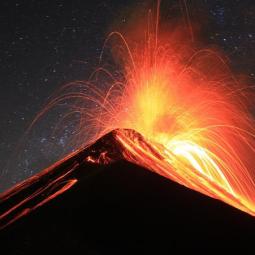Volcanism on Earth and in the solar system

Volcanism on Earth and in the solar system
v/ Pedro Waterton, PhD, Adjunkt, Department of Geosciences and Natural Resource Management, KU
Geology is the study of the Earth: its structure and composition, how it formed, and the various processes that have acted on it in the ~4.5 billion years since it formed in a violent series of collisions at the birth of our solar system. Beyond just studying our own planet, we can use the knowledge we gain from Earth to understand the geological processes acting on various planets and moons in our solar system, as well as potential geological processes operating on exoplanets across the wider universe.
Earth is unique among known planetary bodies. Aside from being the only planet or moon that hosts life, it is also the only planet where active plate tectonics operates.
Plate tectonics – the theory that Earth’s outer shell is made up of a number of rigid plates that move relative to one another – leads to a wide range of volcanic styles on Earth, particularly concentrated along plate boundaries. These range from gentle underwater eruptions at mid-ocean ridges, where new oceanic plates are formed, to catastrophic explosive eruptions above subduction zones, where oceanic plates are destroyed by sinking into Earth’s mantle.
Although other planets and moons do not have plate tectonics, many are volcanically active or were active in the distant past. The lunar maria, the dark patches visible on the moon on a clear night, are vast plains of solidified lava that erupted between 4.3 and 3.1 billion years ago.
Mars is home to Olympus Mons, the largest volcano in the solar system with a height more than two times that of Mount Everest and an area comparable to Poland. There are more than 85000 volcanoes on Venus, including ‘pancake’ lava domes unlike anything seen on Earth. Volcanic eruptions have even been observed on some of Jupiter, Saturn and Neptune’s moons.
In each case, the style of volcanism tells us something about the geological structure and history of the planetary body, and gives us a glimpse into how other planets work.
Nøgleord: Earth’s mantle, Earth’s crust, Plate tectonics, Solar system, Volcano
BEMÆRK: Aktiviteten afvikles i samarbejde med UNF, hvorfor også andre end ATU'ere kan deltage
PRAKTIK: Der er ingen spisepause eller forplejning til denne aktivitet.
FIND VEJ: Du finder lokalet U46 på SDU's hovedgang Gydehutten, her!
AFVIKLER: Der er ingen afvikler fra ATU til stede til denne aktivitet, og du skal derfor fjernregistrere dig som deltager. Du fjernregistrerer dig ved at sende en e-mail til christian@atusyd.dk på dagen, når aktiviteten starter. Forsinkelser og afbud på dagen meldes også til Christian.
-
Antal deltagere15
-
TypeValgfri




 Find us on Facebook
Find us on Facebook
 Join our network
Join our network